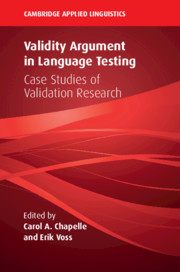Book contents
- Validity Argument in Language Testing
- The Cambridge Applied Linguistics Series
- Validity Argument in Language Testing
- Copyright page
- Contents
- Figures
- Tables
- Contributors
- Series Editor’s Preface
- 1 Introduction to Validity Argument in Language Testing and Assessment
- Part I Basic Concepts and Uses of Validity Argument in Language Testing and Assessment
- 2 Understanding Argument-Based Validity in Language Testing
- 3 A Systematic Review of Argument-Based Validation Studies in the Field of Language Testing (2000–2018)
- Part II Investigating Score Interpretations
- Part III Investigating Score Uses and Consequences
- Part IV Conclusion
- Index
- References
3 - A Systematic Review of Argument-Based Validation Studies in the Field of Language Testing (2000–2018)
from Part I - Basic Concepts and Uses of Validity Argument in Language Testing and Assessment
Published online by Cambridge University Press: 14 January 2021
- Validity Argument in Language Testing
- The Cambridge Applied Linguistics Series
- Validity Argument in Language Testing
- Copyright page
- Contents
- Figures
- Tables
- Contributors
- Series Editor’s Preface
- 1 Introduction to Validity Argument in Language Testing and Assessment
- Part I Basic Concepts and Uses of Validity Argument in Language Testing and Assessment
- 2 Understanding Argument-Based Validity in Language Testing
- 3 A Systematic Review of Argument-Based Validation Studies in the Field of Language Testing (2000–2018)
- Part II Investigating Score Interpretations
- Part III Investigating Score Uses and Consequences
- Part IV Conclusion
- Index
- References
Summary
Since the publication of Kane (2006) on argument-based validation and the validation project by Chapelle, Enright, and Jamieson (2008), a trend of employing argument-based approach in language testing validation research has emerged as observed by Chapelle and Voss (2013). To better understand this recent trend, this systematic review study identified and analyzed the argument-based validation studies published from 2000 to 2018. A comprehensive literature search was conducted with multiple search terms (e.g., validity, argument-based validation, inferences, etc.) on a variety of research publication sources, including peer-reviewed academic journals, research reports, and dissertations. After applying pre-established inclusion criteria, 70 studies were retained, including 45 journal articles or research reports and 25 doctoral dissertations. The claims and inferences employed in these studies were analyzed into themes and categorized under Chapelle, Enright, and Jamieson (2008)’s framework. In addition, the research methodology addressing the warrants, rebuttals and backing in each study was documented and reviewed. Based on the results of this analysis, we make suggestions about constructing interpretation and use arguments as well as evaluating the coherence and plausibility of the validity arguments in various testing contexts.
Keywords
- Type
- Chapter
- Information
- Validity Argument in Language TestingCase Studies of Validation Research, pp. 45 - 70Publisher: Cambridge University PressPrint publication year: 2021
References
References
- 3
- Cited by

